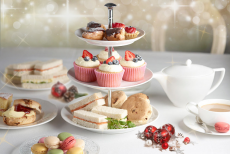
Deborah Patrick
A brief history of afternoon tea in England
Tea is drunk over the world for various reasons, its immense health benefits, and nutritional value, great taste and various reasons known to many. Tea consumption increased dramatically during the early nineteenth century and it is around this time that Anna, the 7th Duchess of Bedford is said to have complained of "having that sinking feeling" during the late afternoon. At the time it was usual for people to take only two main meals a day, breakfast, and dinner at around 8 o'clock in the evening. The solution for the Duchess was a pot a tea and a light snack, taken privately in her boudoir during the afternoon. Later friends were invited to join her in her rooms at Woburn Abbey and this summer practice proved so popular that the Duchess continued it when she returned to London, sending cards to her friends asking them to join her for "tea and a walking the fields."
Other social hostesses quickly picked up on the idea and the practice became respectable enough to move it into the drawing room. Before long all of fashionable society was sipping tea and nibbling sandwiches in the middle of the afternoon. Occasionally you will see hotels serving a 'high tea'. Traditionally, the upper classes would serve a 'low' or 'afternoon' tea around four o'clock, just before the fashionable promenade in Hyde Park. The middle and lower classes would have a more substantial 'high' tea later in the day, at five or six o'clock, in place of a late dinner. The names derive from the height of the tables on which the meals are served, high tea being served at the dinner table. Many visitors from overseas still imagine that we are a nation where, in the words of the well-known song, 'at half past three, everything stops for tea'. Sadly these days Afternoon Tea is usually only an occasional luxury for the British; birthdays treat in a country house hotel, or a welcome break from a hectic days shopping 'in town'. Luckily the tourist is still able to indulge in a little bit of British tradition for themselves.
Tea cups did not always have handles. Chinese tea bowls influenced the first European teacups. At first, the English made cups without handles in the traditional Chinese style. Not until the mid-1750’s was a handle added to prevent the ladies from burning their fingers. This improvement was copied from a posset cup, used for hot beverages-hot drink made of milk with wine, ale or spirits. The saucer was once a small dish for sauce. In Victorian days, tea drinkers poured their tea into saucers to cool before sipping, this was perfectly acceptable
TYPES OF AFTERN00N TEA
Cream tea: Tiny sandwiches or appetizers
Light tea: Tea, scones and sweets
Full Tea - Tea, savouries, scones, sweets and dessert
In England, the traditional time for tea was four or five o'clock and no one stayed after seven o'clock. Most tea rooms today serve tea from three to five o'clock. The menu has also changed from tea, bread, butter and cakes, to include three particular courses served specifically in this order:
Savouries - Tiny sandwiches or appetizers
Scones - Served with jam and Devonshire or clotted cream
Pastries - Cakes, cookies, shortbread and sweets
(Source:www.afternoontea.co.uk/information/history-of afternoon-tea)
Gotten from
https://www.google.co.uk/search?hl=en&site=imghp&tbm=isch&source=hp&biw=1360&bih=618&q=afternoon+tea&oq=afternoon+tea&gs_l=img.3..0l10.1251.4256.0.4568.13.7.0.6.6.0.74.367.7.7.0....0...1ac.1.64.img..0.13.441.kB9YKdvf9zw#imgrc=POVh_Z-bJyfk

0 Comment:
Be the first one to comment on this article.